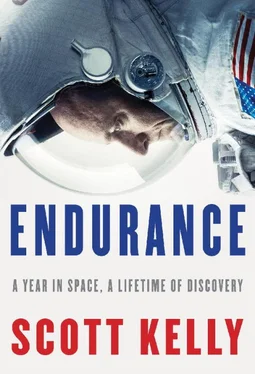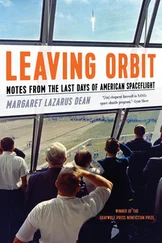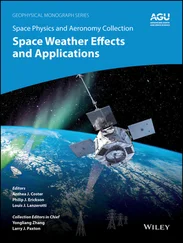I start to head in a direction I think is the right one, then realize it’s wrong, but I can’t tell whether I’m upside down or right side up. I read some mile markers—numbers attached to the handrails—to Megan, hoping she can help tell me where I am.
“It looks much different in the dark,” I tell Megan.
“Roger that,” she says.
“Did I not go far enough aft?” I ask. “Let me go back to my safety tether.” I figure once I find the place where my tether is attached I’ll be able to get my bearings.
“We’re working on cuing up the sun for you,” Megan jokes, “but it’s going to be another five minutes.”
I look in the direction I think is Earth, hoping to catch a glimpse of some city lights 250 miles below in the darkness to get my bearings. If I just knew which way Earth is, I could figure out where I am on the truss. When I look around, all I see is black. Maybe I’m looking right at the Earth and not seeing any lights because we’re passing over the vast expanse of the Pacific Ocean, or perhaps I’m just looking at space.
I make my way back to where my tether is attached, but when I get there, I remember that Kjell had attached the tether, not me, so I’m not familiar with the area. I’m as disoriented as ever. I float for a minute, frustrated, thinking about what to do next.
“Scott, can you see the PMM?”
I can’t, but I don’t want to give up. I see a tether that I think is Kjell’s—if it is, I might be able to figure out where I am.
“Scott,” Megan says, “we’re just going to send you back now—we don’t need to get this, so just head back to where your tether location is and then head back to the airlock.” She takes an upbeat tone, as if this is good news, but she knows it will be frustrating to me to hear they’re giving up on me.
Eventually I catch a glimpse of lights above me. I’m not sure what it is at first, since above me is what I thought was the blackness of space. But as the lights come into focus, I see they are city lights—the unmistakable lights of the Middle East, Dubai, and Abu Dhabi, stretched along the Persian Gulf standing out against the blackness of the water and the desert sands.
The lights reorient me—what I’d thought was down is up—and I feel the strange sensation of my internal gyroscope righting itself. Suddenly it’s clear where I am and where I need to go.
“I see the PMM now, so I think I’m close,” I tell her. “I can go do it. I’d prefer to do it if you guys are okay with it.”
A pause. I know Megan is consulting with the flight director about whether to let me continue or tell me to come back inside.
“Okay, Scott, we’re going to take your lead. We’re happy to have you go and do that.”
“Okay. I think I’m in good shape now.”
When I reach the work site, the sun finally shines over the horizon while Megan talks me through the steps of configuring the vent valve on the ammonia tank. Once I’m done, Megan tells us to head back to the airlock.
I contemplate making a joke to the ground by calling myself “Magellan”—a nickname we used to use in the Navy for those who got lost. But they might not get it, and besides, Magellan was killed before he made it home.
I head back to the airlock, where I climb in first this time and get my tether secured so Kjell can follow. He crams himself in behind me. As he struggles to close the hatch, I try to hook up the oxygen and cooling umbilical to my suit. But my hands are so fatigued I’m fumbling. To make matters worse, my glasses are positioned in such a way that I’m peering at the connection between the umbilical and my suit through the very bottom edge of the lenses, and the distortion prevents me from seeing clearly. I struggle for a good ten minutes, by which time Kjell has maneuvered himself into a position where he can see my connection and help me out. Working together, we get it connected. This is why we do spacewalks in pairs.
Kjell gets the hatch closed, and the air hisses in around us. The carbon dioxide in Kjell’s suit is showing an elevated reading, so when the airlock finishes repressurizing, Kimiya and Sergey hurry to get him out of his helmet first. Through my visor, I can see that he is okay, nodding and talking. It will be ten minutes before Kimiya can take my helmet off. Kjell and I are attached to opposite walls, facing each other, held in place by the racks that secure our spacesuits. We have been in these suits for almost eleven hours. While I float there and wait to get out of my helmet, Kjell and I don’t have to talk—we just share a look, the same look you’d give someone if you’d been riding down a familiar street together, chatting about this and that, and missed by nanoseconds being T-boned by an oncoming train. It’s the look of realizing we’ve shared this experience that we both know was at the limit of our abilities and could have killed us.
When Kimiya lifts my helmet off my head, Kjell and I can finally see each other without plastic in between. We still don’t feel any need for words.
Kjell smiles an exhausted smile and nods at me. His face is pale and sweaty, bathed in the artificial light.
Hours later, Kjell and I pass in the U.S. lab. “There ain’t going to be no rematch,” I say, quoting from Rocky.
“I don’t want one,” says Kjell, laughing his big boisterous laugh.
We have no way of knowing it yet, but only one of us is done with spacewalks.
—
A FEW DAYS LATER, I wake up to find a public affairs event on the schedule with the U.S. House of Representatives Committee on Science, Space, and Technology for both Kjell and me. We’ve been given no preparation or warning, as we should have been for such an important event, and because my day is packed between now and then, I won’t have the chance to get ready. Even worse, when Kjell and I are connected we discover that we are being conferenced into a committee hearing, and that our participation will be considered testimony. I’m furious that the office of public affairs has not given me warning that I will be testifying before a committee of the people who oversee NASA and determine its funding. But I have to set aside that reaction and pretend to be prepared.
Kjell and I answer questions about what we’re doing on station—we describe the biomedical experiments we are taking part in and talk about growing lettuce. One representative points out that we are in a “difficult geopolitical situation” with the Russians and wants to know whether we share all of our data with our Russian colleagues.
I explain that the international cooperation on the space station is its strength. “I was up here as the only American with two Russian guys for six weeks this summer,” I tell him, “and if something had happened to me, I would have counted on them for my life. We have a great relationship, and I think the international aspect of this program has been one of its highlights.”
One of the representatives on the committee, Dr. Brian Babin, happens to be a dentist, and the Johnson Space Center is in his congressional district. He is very curious about our oral health; we assure him that we brush and floss regularly. The last question is about Mars—a representative from Colorado points out that the planets will be lined up advantageously for a voyage in 2033. “Do you guys think that’s feasible?” he asks.
I tell him I personally think it’s feasible, and that the most difficult part of getting to Mars is the money. He knows what I mean without my having to spell it out—we can do it if his committee gives NASA the funding. “I think it’s a trip that is worth the investment,” I say. “I think there are things tangible and intangible we get from investing in spaceflight, and I think Mars is a great goal for us. And I definitely think it’s achievable.”
Читать дальше












